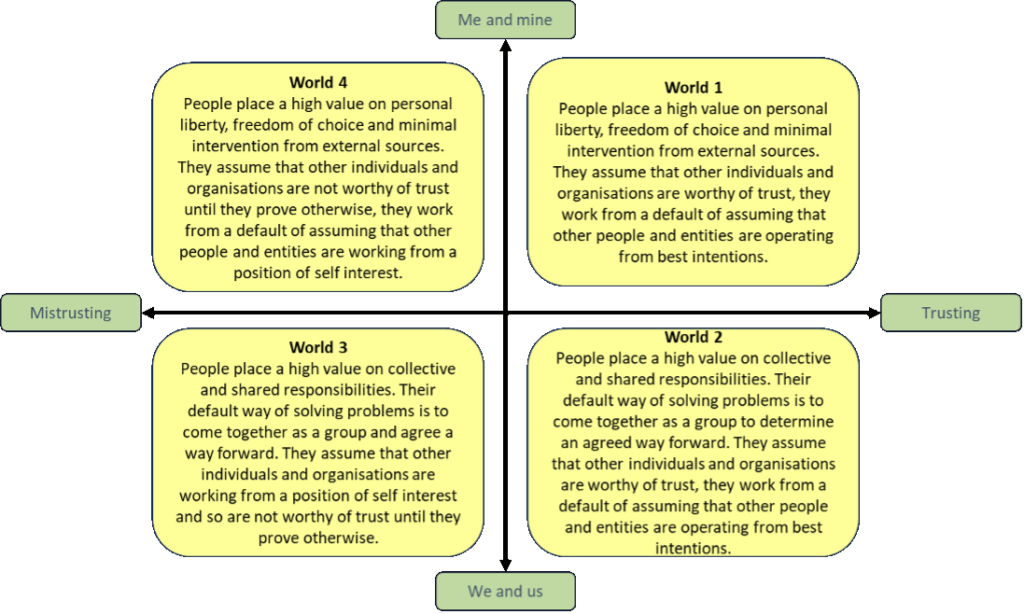The last few years have shown us that the future is uncertain. From advances in technology and the birth of AI, to natural disasters and the rapidly changing landscape of consumer attitudes and demands, it can be particularly difficult to navigate and adapt fast enough to stay relevant and keep thriving in such a volatile environment. Those businesses who successfully stay ahead, are those that can quickly change and evolve to overcome and embrace all the threats and opportunities that are thrown their way.
Scenario mapping – the key to being future-ready
One of the best ways for a business to be prepared for an uncertain future is to collectively explore the potential outcomes, the different scenarios, and to ensure they have a plan of attack around each of the most likely scenarios. Embracing an attitude and a culture that welcomes change and is able to easily adapt is vital in an unpredictable world.
Scenario mapping involves making a number (four is good) of assumptions about what the future environment might look like for your business and how your business responds to each scenario in order to stay abreast and thrive. Scenario mapping provides many benefits including;
- Clearer Strategic Vision focusing on the future and staying relevant
- Improves risk management by proactively preparing for possible risks and challenges, particularly useful when there are limited resources
- Increased resilience – being more prepared in the face of uncertainty with solid contingency plans in place
- Enhanced decision making where collective thought analysis is embraced
- More effective stakeholder engagement and communication comes from such planning, where collaboration is fostered and communication becomes more cohesive and a solid sense of togetherness is created
- Resources can be allocated more effectively by better understanding future scenarios
- The process of imagining different scenarios can spark creativity and innovation which only work to improve businesses
Over the past few months, our team have been working on exploring several possible future outcomes based on societal shifts; specific to the not for profit industry. By researching and interviewing diverse audiences through a combination of desk research, retreats and workshops with clients we have identified Four Future Scenarios on how society could evolve.
These are great in that they can provide a basis for businesses to explore how they could change in order to adapt to each of these four possible future ‘worlds’. In this case our variable or basis was ‘generosity’ – applicable and relevant to not for profit organisations as they need to have an idea of what their possible revenue will look like, driven mainly from donations from their public. Just how generous they are feeling is dependent on a range of variables.
The method used for identifying the 4 worlds, were based on workshops delving into a step-by-step process brainstorming and identifying;
- Megatrends – These trends often emerge from a combination of factors, such as technological advancements, demographic changes, societal shifts, and economic forces. Megatrends are not short-lived fads; they tend to unfold over years or even decades and have a transformative effect on multiple industries and the way people live and work. In the context of our scenario mapping, trends are the things that are likely to happen: they are “probabilities” rather than “possibilities” and, as such, form a backdrop to the scenarios rather than being the factors that define the options.
- Axes of uncertainty – based on the megatrends, these form the basis for potential future scenarios. They ae the uncertain and non-obvious factors art play in unfolding societal change. In this case, the axes were ‘me and mine’ (a self-interested mindset) vs, ‘we and us’ (a collective, community focussed mindset) and ‘trusting’ (people believe others operate with the best intentions and will do what they say) vs ‘mistrusting’ (people believe others are pursuing an agenda that will result in others’ gain and their loss).
- World’s ends – Workshop participants described how the world might look at each end of the spectrum. We then combined their output to create the Four World Models.
- Applied Lenses – We then explored how the world may operate through the perspective of certain ‘lenses’ to enrich the view of the world (e.g. technology, media, workforce). Generosity was applied as the final lens once we had built a big-picture view of society.
Based on analysis and brainstorming of all this and more, the future worlds we came up with looked like this;

As you can see each world assumes a different combination of some of the major themes or variables at play and how that world may play out.
For each ‘world’ the team can then prepare a contingency plan on how they will respond and operate in each ‘world ‘to ensure the business keeps operating to it’s best capacity, staying relevant, agile and adapting easily to it’s changing landscape. In this way, the business can ‘prepare’ for various scenarios. Perhaps upskilling in certain areas, changing operations to be more capable of change, updating technologies and systems and allocating resources to research and development. The team can further list any potential signs or events that might indicate that each particular world could emerge in the near future.
There is no one-size-fits-all process for defining your company/ industry’s future worlds – scenario mapping is an involved and analytical process that is, dare I say, fun! Not only does it bring everyone together in a collaborative and creative environment it is absolutely fundamental to businesses to do in order to prepare for an uncertain future.
I would love to help your business do some scenario mapping in 2024. If you and your team want to kick off the year on the right foot, get in touch today, I’d love to help.
